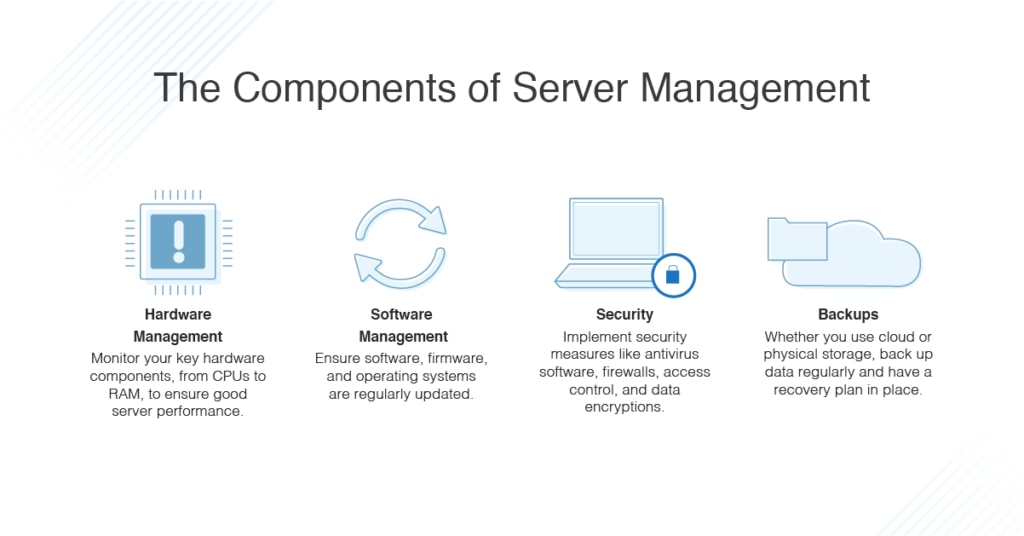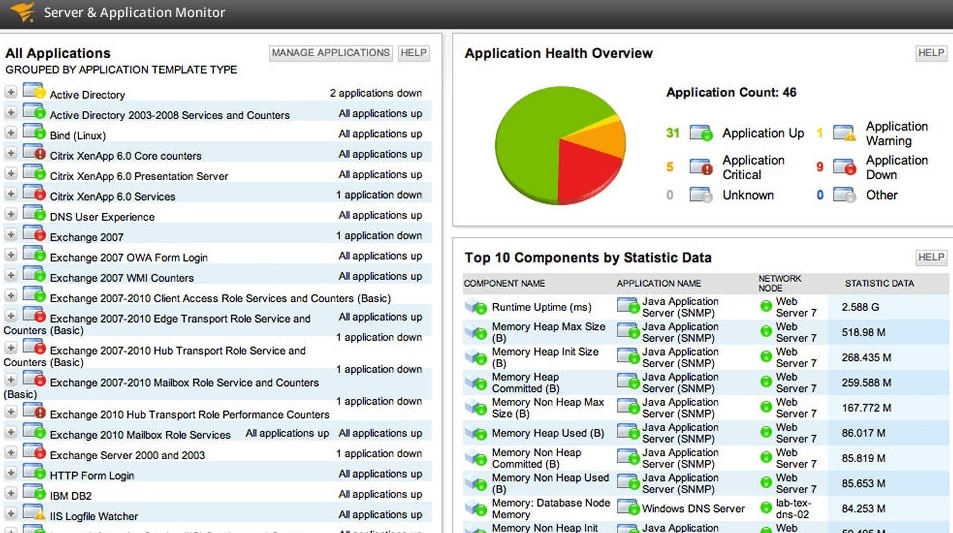Companies depend on their server infrastructure for most IT functions, including data storage, hosting websites, emails, and applications. While many businesses have shifted to cloud services using servers located in enormous, distant data centers, a significant number of organizations still have in-house servers or use a hybrid environment of in-house and cloud services to host server data requiring management. Managing a server, whether in-house or in the cloud, means staying on top of hardware, software, security, and backups.
In this guide, I explore how to best manage servers with an understanding of today’s server technology, security concerns, and touch on the importance of having the right server monitoring software to support your efforts.
- What Is Server Management?
- What Is a Virtual Server?
- Server Management Basics
- Internal Server vs. External Server Monitoring
- How to Choose the Best Server Management Tool
- Final Thoughts on Server Management
What Is Server Management?
Server management is the process of monitoring and maintaining servers to operate at peak performance. Server management also encompasses the management of hardware, software, security, and backups. The primary goals of an effective server management strategy are to:
- Minimize—and hopefully eliminate—server slowdowns and downtime
- Build secure server environments
- Ensure servers continue to meet the needs of an organization as it evolves
What Is a Virtual Server?
Virtualization is a major trend in today’s server environments. While a traditional, physical server is typically a single server running on a single machine, a virtual server can allow multiple servers to be hosted on one piece of hardware.
Virtual servers—also known as virtual machines—can help increase efficiency by enabling more to be done with less hardware. They can be more complex to manage than physical servers, but the same server management principles apply to both. Anyone who manages servers needs to be familiar with a wide range of IT topics like physical vs. virtual servers to understand what environment is best to meet organizational needs.
Server Management Basics
Server management basics include management of hardware, software, security, and backups. The following are important elements of effective server management any IT strategy or software solution should help address:

-
Hardware Management
Keeping hardware performing well is the foundation of effective server management. Without reliable hardware, business productivity can be affected, so it’s important to continuously monitor at least five primary components to help ensure server hardware performance. These hardware components include:
- Central Processing Unit (CPU): The CPU is the brains of a server, performing all the calculations to make programs run. CPUs should be constantly monitored to avoid overuse. A CPU running close to 100% utilization for an extended period is overtaxed, meaning there’s no excess capacity for users to perform additional tasks, risking everything depending on the server slowing to a crawl.
To deal with an overused CPU, you may need to upgrade the chip, add more CPUs, or halt unnecessary programs taking up system resources. A more complex option is tuning the performance of other system elements to put less stress on the CPU. - Random Access Memory (RAM): RAM is a server’s working memory. This form of temporary storage runs faster than permanent hard disks. Programs running from RAM will perform better given this speed advantage.
The more RAM your server has, the better its potential performance. You should keep an eye on RAM usage and consider adding more when it nears capacity. - Hard Drive: The hard drive (also referred to as a hard disk) is a server’s permanent storage. Programs and data are saved here even when the machine is shut down. Performance can degrade when a hard drive nears maximum capacity.
You need to keep track of hard drive storage space, adding new drives or deleting unnecessary data when they fill up (or deciding to invest in a cloud storage solution for more storage capacity). The guide I wrote on how to check your hard drive health also explains how to know when a hard drive is bad. - CPU Temperature: Servers can generate a great deal of heat. Most physical servers come with wired thermometers to help you gauge whether the CPU temperature is in the normal range. If the CPU temperature gets too high, shut down the server immediately and assess the problem.
Cooling fans are another critical component of a physical server. These fans draw in cool outside air and expel hot air warmed by the CPU. If a fan fails, the server can overheat and cause permanent damage. Make sure to monitor fan speeds to avoid temperature spikes. - Operating Environment: In addition to the inside temperate of a server, you should also pay attention to the operating environment where the server is located. A server room must be kept at the proper temperature and humidity—with air flows maintained—for peak server performance and reliability.
When choosing server hardware, it’s important to carefully consider the server specifications you’ll need. It’s best to build in some excess storage and processing capacity, so the server has room to grow with the needs of the business. However, choosing components far beyond your current requirements may result in unnecessary hardware costs in addition to energy usage.
-
Software Management
Just like hardware, server software needs monitoring and regular maintenance. Make sure you understand the software dependencies within your infrastructure, so you can better locate and tune any performance issues.
Also, remember to use basic best practices with application management—existing software, firmware, and operating systems should be regularly updated for both performance and security, as poor performance can drag down other parts of the system and potentially create vulnerabilities that cyberattackers can use to enter your network. It’s also good practice to uninstall old software you’re no longer using.
-
Security
An important component to server management is maintaining a secure network. These security policies can differ depending on the needs and industry type of the business. Common server security solutions include:
- Installing and keeping up-to-date antivirus software
- Putting firewalls in place to keep out unauthorized traffic
- Using a password policy or access control software to only allow secure passwords and require users to regularly change them
- Encrypting sensitive data storage and external network connections
- Implementing SIEM tools
- Analyzing and using security logging best practices to better understand potential threat trends
-
Backups
Your final responsibility to have effective server management is taking regular backups. Losing important data can be a disaster for any enterprise. Fortunately, several robust backup solutions are available in the marketplace, including server backup software to support both physical and virtual servers.
The server’s power supply should also have a backup, so data isn’t lost during a power outage. There are also tools to let you quickly perform and automate backups and recoveries in addition to easily monitoring backup status to avoid potential data loss.
Of course, while many tools are great at helping you manage backups for a single device or network, not all can perform well on a larger scale. If you need to manage backups for many different clients and workstations across multiple networks, you’ll need a different solution to help ensure that your clients’ data is protected, while also saving you as much time as possible.
So if you’re a Managed Service Provider (MSP), we recommend checking out N-able Backup. This solution makes it easy to manage backups for hundreds of clients if necessary, and protect them from errors, hacks, and data loss.
Internal Server vs. External Server Monitoring
Businesses need to choose whether managing servers internally or contracting with an external server management company is the right option—or maybe a mixture of both.
If your enterprise has enough personnel, managing your own servers can provide the advantage of having total control of your server environments. Of course, it’s crucial for team members who manage servers to have the right server monitoring tools at their disposal. Several server management tools exist for system administrators, who rely on features like automated reports and preemptive alerts to stay on top of server health. While some tools simply track performance, other server management software options have more sophisticated abilities to help streamline workflow and even allow for a more proactive approach to server management.
How to Choose the Best Server Management Tool
When researching server management tools, look for software that monitors both the operating system and IT architecture you have in place (including the cloud), and ask yourself these two crucial questions to help ensure your server management software can meet your needs now and in the future:
- Does the server management software monitor across applications, systems, and any XaaS services already in place or planned for use?
- Does the system allow the discovery of root causes for server issues with built-in analytic capabilities?
There’s a lot to stay on top of, but fortunately, some server management software solutions can do all of this in a single package—like my pick for best server management software.
SolarWinds Sever & Application Monitor (SAM)
SolarWinds® SAM is built to provide the server performance monitoring needed to more easily and quickly troubleshoot server issues and optimize server performance. SAM can help prevent outages and maximize server performance by monitoring up and down statuses, capacity, and performance monitoring server hardware components like memory, CPU, and disk I/O.

SAM features real-time and historical trend dashboards designed to pinpoint the actual source of the issue downing the server with the ability to start and stop services, reboot servers, and kill processes all from within the tool. SAM also includes out-of-the-box templates built to monitor server and application performance across multiple vendors and consolidate key server health metrics into centralized console.
Say you have applications in Active Directory as well as servers hosted in AWS. The struggle here is needing a consolidated view across your environment with monitoring information for these separate components in one view alongside your other critical server performance metrics. SAM helps solve this pain point with its ability to provide cloud infrastructure monitoring for AWS environments and Azure instances. Its propriety AppInsight™ application monitoring feature can also pull in metrics from Active Directory, IIS, SQL, and more.
You can tell SAM is designed to address all the different pain points involved in managing the various components of server infrastructures, which often feel are so stretched and separated across an environment. I appreciate the thoughtfulness that went into building a server management software like SAM.
Final Thoughts on Server Management
Having an effective server management strategy can help you avoid downtime, security breaches, and server performance inefficiencies, but the most critical tool in your toolbox when it comes to server management is the server management software you use. That’s why I recommend Server & Application Monitor as a comprehensive server management solution for comprehensive insights in a simplified platform. You can even try a fully functional trial of SAM free for 30 days to see if it’s the best tool for you.
